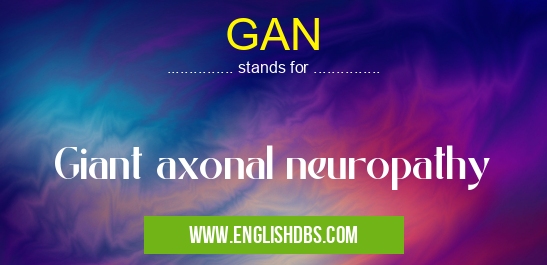What does GAN mean in DISEASES
Giant axonal neuropathy, abbreviated GAN, is an extremely rare genetic disorder that affects the nerves in the brain and spinal cord. It is mainly caused by mutations in a gene called GAN. People with GAN are typically diagnosed at an early age due to symptoms such as delayed walking abilities and muscle weakness, impaired motor coordination, loss of sensation in extremities, and progressive intellectual decline. As the disease progresses over time, it can lead to paralysis or death. Most individuals with GAN will not live past their 20th birthday.

GAN meaning in Diseases in Medical
GAN mostly used in an acronym Diseases in Category Medical that means Giant axonal neuropathy
Shorthand: GAN,
Full Form: Giant axonal neuropathy
For more information of "Giant axonal neuropathy", see the section below.
Symptoms
Symptoms of GAN are often apparent from birth or shortly after. These include delayed walking, reduced muscle tone, lack of coordination and balance, impaired fine motor skills such as handwriting, and difficulty speaking or swallowing. As the disease progresses, individuals may experience sensory deficits such as numbness or tingling sensations in their limbs or a general decrease in sensation in their skin. Other symptoms of advanced GAN include vision problems such as blurred vision and involuntary eye movements (nystagmus), hearing impairment, seizures or epileptic episodes, cognitive decline leading to dementia-like symptoms, and eventually paralysis or death due to respiratory failure.
Diagnosis
Diagnosis of GAN begins with a medical history review followed by physical assessments and neurological tests. Additionally, imaging scans such as MRI may be used to view changes within the brain that indicate abnormalities associated with GAN. Genetic testing can also be used to identify potential mutations in the GAN gene which causes this disorder.
Treatment
Currently there is no cure for GAN but various treatments can be employed to help manage its symptoms and slow its progression. Physical therapy can be used for some individuals with milder forms of GAN to improve their movement capabilities but is generally less useful for those with more severe cases of the disorder. Occupational therapy may help maintain their ability to do daily activities like dressing themselves or brushing their teeth since it focuses on improving coordination and strengthening muscles. Additionally medications can be prescribed for treatment of any accompanying seizure activity.
Essential Questions and Answers on Giant axonal neuropathy in "MEDICAL»DISEASES"
What is Giant Axonal Neuropathy (GAN)?
Giant Axonal Neuropathy (GAN) is a rare neurological disorder characterized by progressive damage to the axons, which are essential for communication between nerve cells. This damage leads to impaired muscle coordination, nerve tissue death, and other symptoms.
How common is GAN?
The exact prevalence of GAN is unknown as most cases are diagnosed posthumously. However, it is estimated to affect approximately 1 in every 100,000 individuals worldwide.
How do people develop GAN?
GAN is caused by genetic mutations in either the gigaxonin gene or the NEFH gene. These genes help produce proteins that play a role in maintaining healthy nerve cells and axons. Mutations in these genes impair production of these proteins resulting in axonal degeneration and eventually leading to GAN.
Who is most at risk for developing GAN?
Individuals of any race can be affected by GAN; however, it appears to have an increased prevalence among Ashkenazi Jews from Eastern Europe and those of Moroccan descent.
What are the signs and symptoms of GAN?
The signs and symptoms of GAN can vary depending on the individual but usually include poor coordination, difficulty standing or walking, mental retardation, learning difficulties, bladder control problems, hearing loss, seizures, abnormal eye movements, paralysis and scoliosis.
At what age does one typically begin to show signs of Gan?
Symptoms typically present within infancy or early childhood but can sometimes be delayed until early adulthood.
Is there a cure for Giant Axonal Neuropathy?
Unfortunately there is currently no cure for Giant Axonal Neuropathy; however treatments exist to manage its symptoms such as physical therapy or occupational therapy for balance issues or seizures medications like anticonvulsants for seizures or spasticity medications such as baclofen for muscle tightness.
How does GAN progress over time?
As time goes on untreated patients with GAN will see a worsening of their symptoms including increasing motor disability as well as progression towards paralysis due to the degeneration of motor neurons within the brain stem and spinal cord.
Final Words:
Giant axonal neuropathy (also known by its abbreviation “GAN”) is an extremely rare genetic disorder that affects the nerves in the brain and spinal cord leading to progressive disability over time until death occurs if untreated. Symptoms include delayed walking abilities along with impaired motor coordination and uncontrollable eye movements as well as sensory deficits like numbness throughout different parts of the body. Diagnosis requires a medical history review followed by physical assessments accompanied by imaging scans if necessary plus genetic testing for possible mutations associated with this disorder while treatment includes therapies like physical or occupational therapy alongside medicines for accompanying seizures..
GAN also stands for: |
|
| All stands for GaN |
